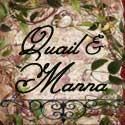Last week, we looked at the Feast of Tabernacles as being focused on God and man dwelling together, about man symbolically leaving the security of his man-made walls and living outdoors in flimsy
"booths" where he must rely fully on God for protection.
At this festival, all Israel is called upon to remember a time when all their descendants lived in booths: "so that your generations may know that I had the sons of Israel live in booths when I brought them out from the land of Egypt" (Lev. 23:43).
In Jesus' day, two specific ceremonies would have been part of the Feast of Tabernacles, both of which served to remind God's children of that time in the desert where His holy presence was physically evident at all times--by day in a pillar of cloud and by night in a pillar of fire.
The first ceremony involved water, a reminder of the water-filled cloud of God's presence during the daytime:1
Imagine a whole parade of worshipers and flutists led by the priest to
the pool of Siloam (where Jesus told the blind man to bathe his eyes
after He put clay over them). The priest has two golden pitchers. One
is for wine. He fills the other with water from the pool. As the
flutes continue to play, a choir of Israelites chants Psalm 118. The
whole procession heads back to the Temple through the Water Gate. A
trumpet sounds as the priest enters the Temple area. He approaches the
altar where two silver basins are waiting. He pours wine into one of
the basins as a drink offering to the Lord and water from the pool of
Siloam into the other. The whole ceremony, with the parade and the
flutes and the singing, was such a joyful occasion that one of the
ancient rabbis wrote: "Anyone who has not seen this water ceremony has
never seen rejoicing in his life." The ceremony was to thank God for His bounty and to ask Him to provide rain for the crops in the coming year."2
The second ceremony involved fire, a great light, reminiscent of the pillar of fire the Israelites would have seen as they broke for camp in their booths each evening.
On the evening of the first day of the Feast, four 75-foot tall menorahs would be lit in the Temple's Court of the Women and would burn for the duration of the feast. With the Temple resting high upon a hill above the city of Jerusalem, this was truly a brilliant light placed where all to see. There was no missing it.
Surely, at least some of Jesus' disciples saw the light of these menorahs illuminating the impenetrable darkness only found in a pre-electricity world and remembered His words in Matthew, exhorting His disciples: "You are the light of the world. A town built on a hill cannot be hidden. Neither
do people light a lamp and put it under a bowl. Instead they put it on
its stand, and it gives light to everyone in the house. In the same way, let your light shine before others, that they may see your good deeds and glorify your Father in heaven" (Matt. 5:14-16).
This Feast, like all the others, draws all of Israel to remember God's faithfulness while also looking toward Christ as the fulfillment as all parts of the Feast.
In John 7, Scripture records Jesus actually attending the Feast of Tabernacles. Yet, only at the end of the festival does he reveal Himself in both of these ceremonies. John says, "On the last and greatest day of the festival, Jesus stood and said in a loud voice, “Let anyone who is thirsty come to me and drink. Whoever believes in me, as Scripture has said, rivers of living water will flow from within them" (Jn. 7:37).
Without knowing about the water ceremony, Jesus' statement seems to come out of nowhere. But knowing of the tradition of giving thanks to God for life-giving water, Jesus' claim to give this sustaining water suddenly makes perfect sense. Here, He promised the Holy Spirit for believers. He expressed His divinity to an audience, some of whom understood His true meaning that He was Messiah.
After this revelation, Scripture records Jesus going to the Mount of Olives. The next morning after the Feast's conclusion, Jesus re-entered the Temple: "At dawn he appeared again in the temple courts, where all the people gathered around him" (Jn. 8:2).
Imagine the scene: after seven days, the immense light from these 75 foot menorahs would suddenly be gone. How dark it must have seemed to those who had lived in the shadow of its illumination. Then, in the midst of this darkness, in the same location where those candles would have been shining mere hours before, Jesus speaks to this second ceremony of lights: "When Jesus spoke again to the people, he said, 'I am the light of the world. Whoever follows me will never walk in darkness, but will have the light of life'" (Jn. 8:12).
Here, Jesus reveals Himself to be the light that never is extinguished. He is the true light set upon a hill, the Messiah they had so long waited for...if only their eyes could have been opened to see that light in the midst of their spiritual darkness.
Today, we are blessed to live this side of the cross. Two thousand years later, Jesus is still the living water that will never run dry. He remains the light of the world. These gifts of His presence--water and light--the same ones God offered to the Israelites...He offers the same to you and to me through His Son Jesus, if we will only believe with our whole heart, soul, and mind.
1. Nadler, Sam. Feasts of the Bible. "Feast of Tabernacles." Video. Torrance: Rose P, 2011.
2. *"Christ in the Feast of Tabernacles" by Jews for Jesus.
Image: "Light Upon a Hill" by awesome photographer D. M. Weber
Other Articles in this Jewish Feasts Series:
A Doorway But No Roof: God's Annual Camp-out
When The Books Are Closed: A Look at Yom Kippur
A One Hundred Trumpet Blast Wake-Up Call
Positioning Passover Pronouns
Preparation Day: 'Go to Church' or Worship
Reorienting Our Lives: 50 Days From the Cross
Understanding the Jewish-ness of Jesus
The Truth About Passover
Tuesday, July 2, 2013
God's Annual Camp-out (Part 2)
Labels:
cloud,
Feast of Booths,
Feast of Tabernacles,
Israel,
Jesus,
Jewish Feasts,
Messiah,
pillar of fire
Subscribe to:
Post Comments (Atom)









No comments:
Post a Comment